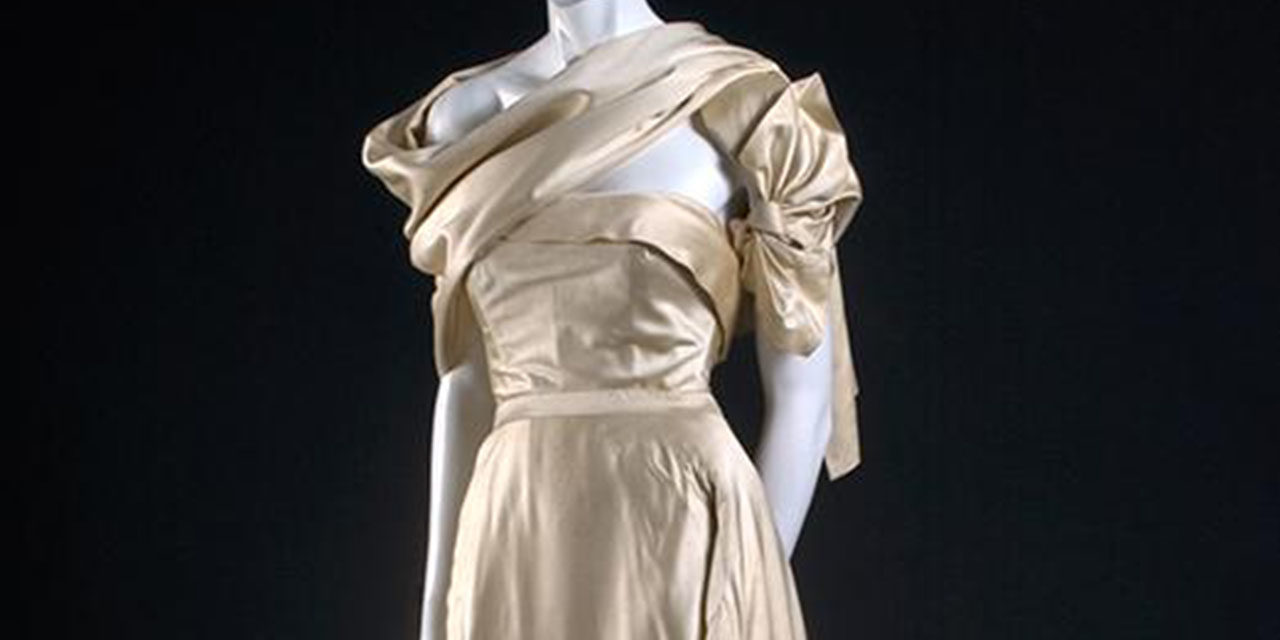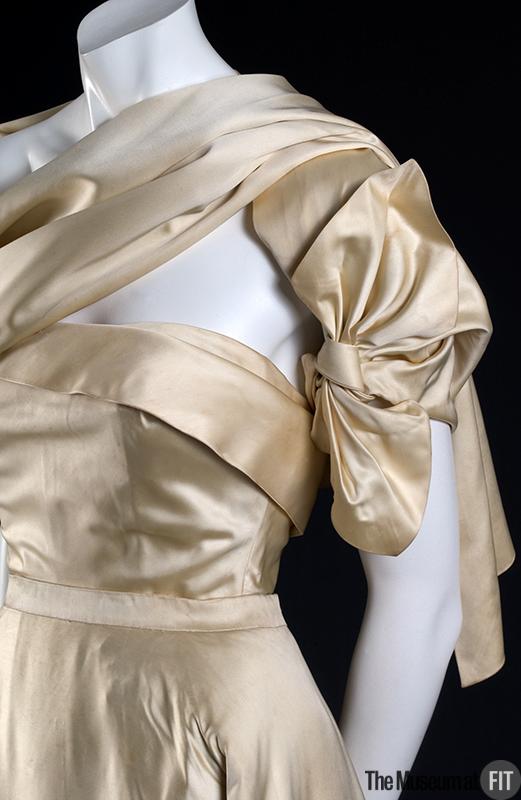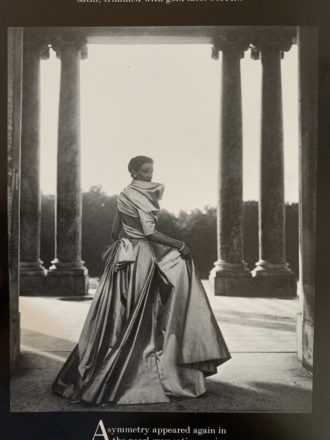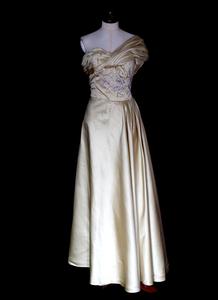This Dior evening dress embodies the elegance of Dior’s 1948 collection and fashionably exhibits the New Look silhouette of the time.
About the Look
This evening ensemble is a luxurious silk satin gown (Fig. 1) designed by Dior for his Fall/Winter 1948 collection. This fabric is highly lustrous candlelit satin that causes the pleats and folds to shine. The base bodice is a fairly simple design – a strapless bodice that folds over straight across the top. It becomes more complex around the arms; drapery in the same fabric flowing around the shoulders, across the chest, and ties in a dramatic bow on the right arm. This creates a zig-zag shape across the top part of the body – appropriate, as the title of this collection was Zig Zag.
A slim waistband pulls the waist tight, and the skirt begins to gently flare out from the waistline. The volume in the skirt comes from gores at the side, which falls several inches lower to the ground than the center panels. The soft draping of the silhouette paired with the long hemline is very feminine. The Museum at FIT explains the impact of Dior’s 1947 New Look in relation to this 1948 Dior gown:
“Suddenly, the boxy, man-tailored styles of the war years were démodé, replaced by an ultra-feminine style characterized by luxurious, long, full skirts and hourglass bodices.”
Fig. 1 - Christian Dior (French, 1905-1957). Evening Ensemble, Fall 1948. Off-white silk satin. New York: The Museum at FIT, 70.57.48. Gift of Mr. Rodman A. Heeren. Source: MFIT
Christian Dior (French, 1905- 1957). Evening Ensemble, Fall 1948. Off-white silk satin. New York: The Museum at FIT, 70.57.48. Gift of Mr. Rodman A. Heeren. Source: The Museum at FIT
About the context
Dior’s 1948 Zig Zag collection was his introduction to asymmetry in design and added a creative twist to his masterful tailoring. His inspiration for the collection came from motion and shape and was particularly derived from the way that fashion sketches can have a special sense of movement. In Dior in Vogue (1981), Brigid Keenan explains: “Zig Zag was the name given to the Autumn collection, its aim being to give the figure the animated look of a drawing” (44). Dior was able to bring a sense of liveliness to his drawings and wanted his models to reflect the visual world he created when designing the garments. His understanding and intense thought about the process of design is reflected in his ability to create complex draped garments that still maintain this animated look.
Diana De Marly writes about the theme of the 1948 collection in Christian Dior (1990): “The main theme of this collection was the ‘geometric rigor’ and drapery particularly in Dior’s elegant evening dresses” (33). In figure 2, his famous Cyclone gown from the same collection shows how Dior carried this motif of asymmetry and shape into other garments to establish his theme. Playful drapery is a key element in this particular evening ensemble (Fig. 1) as it was a way for Dior to effectively communicate his inspiration to the world in a visually pleasing manner.
In the March 30, 1948 article “Dresses: For Fall: Back-Up Back-Interest Early,” a Women’s Wear Daily staff writer described Dior’s dresses and design elements:
“Variations on the skirts that sweep backward are those with much width at the hemline, swinging stiffly from a slim hip. Side folds and shirring are shown for both younger and more mature sizes, and Dior’s en vol silhouette with the front drape recurs on several lines.” (14)
The en vol silhouette created garments that flared out elegantly from the waist. This silhouette was inspired by the success of his introduction of the ultra-feminine New Look silhouette the previous year. In figure 3, the model lifts up side panels to reveal the hidden volume of each and the fullness of the skirt. This shoot helpfully provides the original silhouette and styling of the FIT dress, as skirt supports and accessories are not present on the FIT mannequin.
A Women’s Wear Daily article called “Paris Couture Openings at Peak” from February 9th, 1948 noted the influential pieces and design details of the evening wear dresses in Dior’s fall collection:
“There are slinky, straight evening gowns with a stiff ruffle decolletées that frame the face and shoulder… with a knife pleated skirt and sash bow at the back. New looking are slender, supple trailing gowns of colored chiffons which any woman could wear.” (3)
Zig Zag was incredibly popular and had an overwhelmingly positive reaction, particularly among younger customers. In “Paris Couture Openings at Peak” the reaction to the collection is described: “Despite gowns of limitless yardage, and rich costume jewelry and embroideries, the general impression is modern and wearable” (3). These dresses allowed the customer to feel luxurious and elegant, but not too flashy or extravagant. Dior was able to achieve that perfect balance (Fig. 4). With Zig Zag, Dior took the opportunity to not only work with ultra-femme silhouettes, but to combine his knowledge of menswear with new feminine shapes (Fig. 5).
Brigid Keenan in Dior in Vogue (1981) discusses how the 1948 collections impacted global travel:
“In 1948, Vogue claimed that the Paris collections helped account for the sudden growth of traffic across the Atlantic – 250,000 people crossed from America to Europe that summer. Among them were ‘American women: private clients of French makers before the War, younger ones who had never seen a Paris collection before.’” (44)
The collection reached customers not only in Europe, but also in America. The war had just ended and now younger American customers were able to access his designs and travel to Europe to experience his collections. But while younger women loved Dior’s New Look, Dior faced some opposition from the older generation.
In Christian Dior (1990), Diana De Marly explains that:
“Many British women said that they would refuse to wear the New Look because of the difficulties it involved. Their teenage daughters felt differently. They were just at the age when they wanted to identify their own generation, so the new look was their uniform, no matter how problematic it would prove to achieve.” (31).
The New Look (Fig. 6) allowed the younger generation to set themselves apart from older fashions (Fig. 7). It was something new and beautiful in a world that was previously filled with loss and war. Older women did not quite see this appeal, having previously lived through similar silhouettes in fashion. The more practical women did not see it as achievable or affordable due to the amount of fabric required to make one at home, and the price of the models offered by Dior.
Dior was highly influential from his debut and was considered a trendsetter who many designers looked to for inspiration even in these early years. Soon after its introduction, practically every fashion house was showing their own version of Dior’s New Look silhouette. A contemporaneous gown (Fig. 8) made to be sold in a department store looks almost identical to the piece in figure 1. The asymmetry on the top, the silhouette, and fabric are very similar, but lacking in technical prowess. Dior’s work inspired waves of copies (Fig. 9), and his influence on other designers cannot be overestimated.
In the article “Fashion Significances: A Thousand and One Dresses for 1948 Night” Women’s Wear Daily writes about Dior’s influence on new trends and the impact of standout evening pieces in the Fall 1948 Collections:
“These elaborations of skirts of this year recall largely the influence of Dior and Charles James.
This was the year – 1948 – when the word ‘glamour’ had less circulation in the selling lingo of fashions, and yet, this year, especially the fall and winter will be memorable for the part ‘glamour’ portrayed in evening fashions.” (3)
Christian Dior was one of the most talented designers of his time, and his house is still regarded as an exceptional luxury brand. This Fall/Winter 1948 collection was one of the collections that featured his New Look silhouette, which he is most iconic for. This collection was typical of a Dior collection in the regard that he presented masterpieces of garments that embodied pure elegance but is unique in its introduction of asymmetry and modern flair.
Fig. 2 - Christian Dior (French, 1905-1957). Robe Cyclone, Fall/Winter 1948. Photo by Jean Guichard. Source: CR Fashion Book
Fig. 3 - Christian Dior (French, 1905-1957). Dior Evening Gown, Fall 1948. Silk satin. p. 52. Source: Dior In Vogue
Fig. 4 - Christian Dior (French, 1905-1957). Eventail (Fan), Fall/Winter 1948. Wool. New York: The Metropolitan Museum of Art, 2006.20a–c. Isabel Shults Fund, 2006. Source: MMA
Fig. 5 - Christian Dior (French, 1905-1957). Girouette, Fall/Winter 1948. Black gros de tours, velvet. Fine Arts Museums of San Francisco, 1987.25.3a-c. Bequest of Jeanne Magnin. Source: FAMSF
Fig. 6 - Christian Dior (French, 1905-1957). Poulette, Fall/Winter 1948. Black silk faille; (63 x 17 11/16 in). San Francisco: De Young Museum, 1982.18.4a-b. Gift of Mrs. Eloise Heidland. Source: WSJ
Fig. 7 - Christian Dior or Pierre Balmain for Lucien Lelong (French). Lettre d' Amour, Autumn/Winter 1943. Black lace and velvet; bust 86, waist 66 cm (bust 34, waist 26 in). London: Kerry Taylor Auctions, Lot 57, Passion for Fashion, June 8, 2010. Source: Invaluable
Fig. 8 - Elizabeth Henry. 1940s Light Gold Beaded Satin Gown, Late 1940s. Silk duchess satin; (bust 36, waist 30 in). Alexandra King Vintage. Source: Alexandra King
Fig. 9 - Designer unknown (copy of Christian Dior). Dress, ca. 1948. Silk. New York: Metropolitan Museum of Art, 2009.300.7607a, b. Source: MMA
References:
- Cole, Daniel James, and Deihl, Nancy. The History of Modern Fashion from 1850. London: Laurence King Publishing, 2015. http://www.worldcat.org/oclc/900012311
- De Marly, Diana. Christian Dior. London: B.T. Batsford, 1990. http://www.worldcat.org/oclc/906551406
- “Dresses: For Fall: Back-Up Back-Interest Early: Back Interest, Newest Silhouette Contribution for Fall, Indicates Quick and Early Promotions to Catch Sales before Consumer Interest Wanes — New Budget Dresses use Stiffening at Hemline and Hip to “Freeze” Folds in Space — Fabrics to be Stiff and Lustrous for Fall.” Women’s Wear Daily 76, no. 62 (Mar 30, 1948): 14. https://search.proquest.com/docview/1564901206?accountid=27253
- “Evening Ensemble.” The Museum at FIT. The Fashion Institute of Technology, 2015. http://fashionmuseum.fitnyc.edu/view/objects/asitem/search$0040/6/dynasty-desc?t:state:flow=ff96aed1-6ebe-45f3-8c8b-bda212c387d1
- “Fashion Significances: A Thousand and One Dresses for 1948 Nights: Evening Dresses in Unprecedented Role in Building Up Prestige and Stimulus for 1948 Fashions ‘they are Wearing’.” Women’s Wear Daily 77, no. 123 (Dec 24, 1948): 3. https://search.proquest.com/docview/1565420388?accountid=27253
- Keenan, Brigid. Dior in Vogue New York: Harmony Books, 1981. http://www.worldcat.org/oclc/11575556
- “Paris Couture Openings at Peak: Dior Silhouette Acclaimed again, Combining Slim, Stiffened Lines: Large Collection Stresses Ensembles Complete with Hats, Shoes and Accessories—”Zig Zag” and “En Vol” Featured Silhouettes — Belted “Nonchalant” Coat Lines Cited.” Women’s Wear Daily 76, no. 27 (Feb 09, 1948): 3. https://search.proquest.com/docview/1627552720?accountid=27253



















